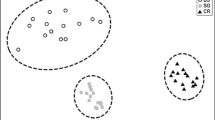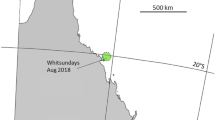Abstract
Patterns of abundance, age structure and recruitment of coral trout (Plectropomus leopardus) and snapper (Lutjanus carponotatus) were described in different environments, which varied in benthic cover, in a 12-yr study at One Tree Island. It was hypothesized that both taxa would show strong preferences to different environments and benthic cover and that patterns would be consistent through time. Plectropomus leopardus were abundant on the reef slope and seaward edge of the lagoon, where live coral cover was high, and recruitment was generally low, in all environments. The population was sustained by a trickle of recruits, and total abundance varied little after 10 to 25 yr of protection in a no-take area, suggesting P. leopardus had reached an environment-related carrying capacity. Protogynous P. leopardus recruited to shallow environments at sites with 20% or more hard live coral and age data indicated the abundance of fish on the reef slope was from redistribution. Most recruits of gonochoristic L. carponotatus (<150 mm Standard length, SL) were found in the lagoonal environments, and adults were rare on the reef slope. Abundance of recruit L. carponotatus and P. leopardus did not correlate with percent cover of live and soft coral within environments. Recruits of L. carponotatus were usually rare in all lagoonal environments, but in 2003, many recruits (80 to 120 mm SL) were found in lagoonal environments with low and high hard live coral cover. A substantial proportion of the population (age max 18 yr) was from strong recruitment events. In 2003 and 2004, total abundance of L. carponotatus was supported by 1 year class 51.7 and 41% respectively. The utilization of environments and types of substrata varied among taxa and in some cases among life-history stages. There was also temporal variation in the importance of some environments (e.g. Lagoon Centre).








Similar content being viewed by others
References
Adams S (2003) Morphological ontogeny of the gonad of three plectropomid species through sex differentiation and transition. J Fish Biol 63:22–36
Adams AJ, Ebersole JP (2004) Processes influencing recruitment inferred from distributions of coral reef fishes. Bull Mar Sci 75:153–174
Anderson MJ, Willis TJ (2003) Canonical analysis of principal coordinates: a useful method of constrained ordination for ecology. Ecology 84:511–525
Booth D, Beretta G (2002) Changes in a fish assemblage after a coral bleaching event. Mar Ecol Prog Ser 245:205–212
Booth DJ, Kingsford MJ, Doherty PJ, Berretta GA (2000) Recruitment of damselfishes in One Tree Island lagoon: persistent interannual spatial patterns. Mar Ecol Prog Ser 202:212–230
Cappo M, Eden P, Newman S, Robertson S (2000) A new approach to validation of periodicity and timing of opaque zone formation in the otoliths of eleven species of Lutjanus from the central Great Barrier Reef. Fish Bull 98:474–488
Caselle JE, Warner RR (1996) Variability in recruitment of coral reef fishes: the importance of habitat and two spatial scales. Ecology 77:2488–2504
Choat JH, Axe LM (1996) Growth and longevity in acanthurid fishes: an analysis of otolith increments. Mar Ecol Prog Ser 134:15–26
Connell SD (1997) The relationship between large predatory fish and recruitment and mortality of juvenile coral reef-fish on artificial reefs. J Exp Mar Biol Ecol 209:261–278
Connell SD (1998) Patterns of piscivory by resident predatory reef fish at One Tree Reef, Great Barrier Reef. Mar Freshw Res 49:25–30
Connell SD, Jones GP (1991) The influence of habitat complexity on postrecruitment processes in a temperate reef fish population. J Exp Mar Biol Ecol 151:271–294
Connell SD, Kingsford MJ (1998) Spatial, temporal and habitat-related variation in the abundance of large predatory fish at One Tree Island, Australia. Coral Reefs 17:49–57
Doherty PJ (2002) Variable replenishment and the dynamics of reef fish populations. In: Sale PF (ed) Coral reef fishes: dynamics and diversity in a complex ecosystem. Academic Press, London, pp 327–358
Doherty PJ, Williams DM (1988) The replenishment of coral reef fish populations. Oceanogr Mar Biol Annu Rev 26:487–551
Eggleston DB (1995) Recruitment in Nassau grouper Epinephelus striatus: post-settlement abundance, microhabitat features, and ontobenthic habitat shifts. Mar Ecol Prog Ser 124:9–22
Evans RD, Russ GR (2004) Larger biomass of targeted reef fish in no-take marine reserves on the Great Barrier Reef, Australia. Aquat Conserv 14:505–519
Ferreira BP, Russ GR (1992) Age growth and mortality of the inshore coral trout Plectropomus leopardus (Pisces: Serranidae) from the central Great Barrier Reef, Australia. Aust J Mar Freshw Res 43:429–440
Ferreira BP, Russ GR (1994) Age validation and estimation of growth rate of the coral trout, Plectropomus leopardus, (Lacepede 1802) from Lizard Island, Northern Great Barrier Reef. Fish Bull 92:46–57
Ferreira BP, Russ GR (1995) Population structure of the leopard coral grouper, (Plectropomus leopardus), on fished and unfished reefs off Townsville, Central Great Barrier Reef, Australia. Fish Bull 93:629–642
Francis MP (1995) Spatial and seasonal variation in the abundance of juvenile snapper (Pagrus auratus) in the north-western Hauraki Gulf. NZ J Mar Freshw Res 29:565–579
Friedlander AM, Parrish JD, DeFelice RD (2002) Ecology of introduced snapper Lutjanus kasmira (Forsskål) in the reef fish assemblage of a Hawaiian bay. J Fish Biol 60:28–48
Goeden GB (1978) A monograph of the coral trout Plectropomus leopardus (Lacepede). Qld Fish Serv Res Bull 1:1–42
Hixon MA (1991) Predation as a process structuring coral-reef fish communities. In: Sale PF (ed) The ecology of fishes on coral reefs. Academic Press, London, pp 475–508
Jackson JBC, Kirby MX, Berger WH, Bjorndal KA, Botsford LW, Bourque BJ, Bradbury RH, Cooke R, Erlandson J, Estes JA, Hughes TP, Kidwell S, Lange CB, Lenihan HS, Pandolfi JM, Peterson CH, Steneck RS, Tegner MJ, Warner RR (2001) Historical overfishing and the recent collapse of coastal ecosystems. Science 293:629–638
Jennings S, Kaiser MJ, Reynolds JD (2001) Marine Fisheries Ecology. Blackwell Science, Oxford
Jones GP (1984) Population ecology of a temperate reef fish Pseudolabrus celidotus Bloch & Schneider (Pisces: Labridae): II. Factors influencing adult density. J Exp Mar Biol Ecol 75:277–303
Jones GP (1991) Postrecruitment processes in the ecology of coral reef fish populations: a multifactorial perspective. In: Sale PF (ed) The Ecology of fishes on coral reefs. Academic Press, New York, pp 294–328
Jones GP, McCormick MI, Srinivasan M, Eagle JV (2004) Coral decline threatens fish biodiversity in Marine Reserves. Proc Natl Acad Sci USA 101:8251–8253
Kingsford MJ (1992) Spatial and temporal variation in predation on reef-fishes by coral trout (Plectropomus leopardus), Serranidae. Coral Reefs 11:193–198
Kingsford MJ (1998) Analytical aspects of sampling design. In: Kingsford MJ, Battershill CN (eds) Studying temperate marine environments: a handbook for ecologists. University of Canterbury Press, Christchurch, New Zealand, pp 49–83
Kingsford MJ, Battershill CN (1998) Procedures for establishing a study. In: Kingsford MJ, Battershill CN (eds) Studying temperate marine environments: A handbook for ecologists. Canterbury University Press, Christchurch, New Zealand, pp 29–48
Kingsford MJ, Hughes JM (2005) Patterns of growth, mortality and size of a tropical damselfish Acanthochromis polyacanthus across the continental shelf of the Great Barrier Reef. Fish Bull 103:561–573
Kritzer JP (2002) Variation in the population biology of stripey bass Lutjanus carponotatus within and between two island groups on the Great Barrier Reef. Mar Ecol Prog Ser 243:191–207
Kritzer JP (2004) Sex-specific growth and mortality, spawning season, and female maturation of the stripey bass (Lutjanus carponotatus) on the Great Barrier Reef. Fish Bull 102:94–97
McPherson G, Squire L, O’Brien J (1988) Demersal reef fish project 1984–85: Age and growth of four important reef fish species. Fisheries Research Branch Technical Report No. FRB 88/6, Cairns
Moe MAJ (1969) Biology of the reef grouper Epinephelus morio (Valenciennes), from the eastern Gulf of Mexico. Professional Paper Series, Florida Department of Natural Resources. Marine Research Laboratory 10:1–95
Nadon M-O, Stirling G (2006) Field and simulation analyses of visual methods for sampling coral cover. Coral Reefs 25:177–185
Newman SJ, Williams DM (1996) Variation in reef associated assemblages of the Lutjanidae and Lethrinidae at different distances offshore in the central Great Barrier Reef. Environ Biol Fish 46:123–138
Newman S, Cappo M, Williams D (2000) Age, growth and mortality of the stripey, Lutjanus carponotatus (Richardson) and the brown-stripe snapper, L. vitta (Quoy and Gaimard) from the central Great Barrier Reef, Australia. Fish Res 48:263–275
Russ GR (1984) Distribution and abundance of herbivorous grazing fishes in the central Great Barrier Reef. I. Levels of variability across the entire continental shelf. Mar Ecol Prog Ser 20:23–34
Russ GR, Alcala AC (1996) Marine Reserves: rates and patterns of recovery and decline of large predatory fish. Ecol Appl 6:947–961
Russ GR, Lou DC, Ferreira BP (1995) A long-term study on population structure of the coral trout Plectropomus leopardus on reefs open and closed to fishing in the central great Barrier Reef, Australia. CRC Reef Research Centre. Technical Report No. 3. Townsville
Russell DJ, McDougall AJ (2005) Movement and juvenile recruitment of mangrove jack Lutjanus argentimaculatus (Forsskål), in northern Australia. Mar Freshw Res 56:465–475
Samoilys MA (1997) Periodicity of spawning aggregations of coral trout Plectropomus leopardus (Pisces Serranidae) on northern Great Barrier Reef. Mar Ecol Prog Ser 160:149–159
Schnute J (1981) A versatile growth model with statistically stable parameters. Can J Fish Aquat Sci 38:1128–1140
Underwood AJ, Petraitis PS (1993) Structure of intertidal assemblages in different locations: how can local processes be compared? In: Ricklefs R, Schulter D (eds) Species diversity in ecological communities. University of Chicago Press, Chicago, pp 38–51
Veron JEN (2000) Corals of the world. Australian Institute of Marine Science, Townsville
Warwick RM, Clarke KR (1991) A comparison of some methods for analysing changes in benthic community structure. J Mar Biol Assoc UK 71:225–244
Williams DM (1991) Patterns and processes in the distribution of coral reef fishes. In: Sale PF (ed) The ecology of fishes on coral reefs. Academic Press, San Diego, pp 437–474
Woods AE, Ellis RC (1994) Laboratory histopathology: a complete reference. Churchilll Livingstone, Edinburgh
Zeller DC, Russ GR (1998) Marine reserves: patterns of adult movement of the coral trout (Plectropomus leopardus (Serranidae)). Can J Fish Aquat Sci 55:917–924
Acknowledgements
For assistance with benthic counts I thank Ben Stewart, Julian Hughes, Dave Welch and Mark O’Callaghan and Mark, Tim Glasby and Mathew Galetto for helping with aging fish. Many thanks to Naomi Gardiner for assistance with graphics and analyses. This research was supported by multiple grants from the Australian Research Council.
Author information
Authors and Affiliations
Corresponding author
Additional information
Communicated by Ecology Editor Prof. Peter Mumby.
Rights and permissions
About this article
Cite this article
Kingsford, M.J. Contrasting patterns of reef utilization and recruitment of coral trout (Plectropomus leopardus) and snapper (Lutjanus carponotatus) at One Tree Island, southern Great Barrier Reef. Coral Reefs 28, 251–264 (2009). https://doi.org/10.1007/s00338-008-0421-4
Received:
Revised:
Accepted:
Published:
Issue Date:
DOI: https://doi.org/10.1007/s00338-008-0421-4




